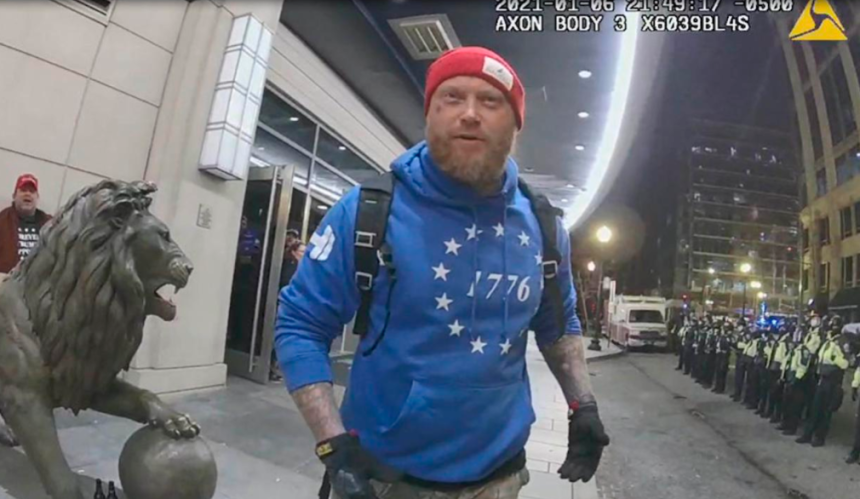On Friday, a Texas man was sentenced to seven years in jail for using a metal tomahawk to attack the United States Capitol. He’s also the cover photo for a website that sells merchandise depicting convicted rioters as “political prisoners.”
Shane Jenkins, 46, attempted to shatter a glass in the Capitol with his tomahawk during the siege that began on January 6, 2021. Among the items he tossed at police officers were a desk drawer, a flagpole, a metal walking stick, and a wooden pole with a spear-like end.
Jenkins is listed as the founder of the organization on a website that seeks to “expose the government’s treatment of the January 6th defendants.” “Free the J6 political prisoners” and “Want my vote?” are among the numerous January 6-related slogans offered on the site’s retail store. Support the J6ers! Another outfit has a photograph of former President Donald Trump and the words “Indicted we stand.”
Jenkins is also recognized on the website for his role in the revolt. Skullet, Jenkins’ cartoon avatar, is present, as is a logo of crossed tomahawks and a silhouette of the Capitol.
The prosecution does not know how much money Jenkins gained from the website’s merchandise sales. However, it was revealed that he had previously raised about $118,000 via another website.
In a court statement, prosecutors stated that instead of “contemplating the harm he has caused, examining his conscience, feeling shame for his actions, and resolving to change,” Jenkins has “chosen to use his January 6 status to build a brand in order to garner money and attention.”
According to defense counsel Dennis Boyle, Jenkins has not benefitted from the sale of January 6 items. Boyle, however, did not divulge who owns the website selling the items.
Jenkins’ attempt to benefit from his role in the event was labeled “shameful” by U.S. District Judge Amit Mehta during his sentence. The court also rejected accusations that Jenkins and the other detained rioters are political prisoners who would not be given a fair trial.
According to Mehta, there is “absolutely no truth” to that. They had it on video.
Jenkins apologized on January 6 for his actions, stating he got “caught up in the heat of the moment.”
“I love this country,” he told the judge. To make matters worse, “I’m not some crazed maniac out to destroy this nation.”
Prosecutors requested a sentence of 19 years and 8 months in prison. They requested a fine of at least $118,888, the same amount Jenkins had received from the general public.
Mehta declined to inflict any punishment on them. In addition, the judge rejected to apply a “terrorism” enhancement to the sentencing guidelines, which would have significantly increased the sentence.
Jenkins was convicted by a jury in March on a variety of offenses, including civil disturbance and disrupting the joint session of Congress on January 6. Jenkins was present to certify that Democrat Joe Biden had won the presidential election against Republican Donald Trump.
Jenkins traveled in from Houston ahead of Trump’s gathering outside the White House on January 6. Prosecutors claim Jenkins witnessed a “medieval melee style battle” erupting at the Capitol as a result of his conviction that Trump’s 2020 presidential election was stolen.
The purpose of his actions, they found, “was to intimidate and retaliate against a government that would not install his preferred candidate, and his language invoked imagery of war and violent retribution.”
Jenkins’ “misunderstanding about the election,” according to Boyle, prompted the events of January 6.
The “great lie” that Trump won the election is still being disseminated by “many grifters,” according to Boyle, with Trump being one of the most well-known. According to the author, “Mr. Jenkins is not one of these individuals; he knows he was wrong.”
Jenkins had a terrible and traumatic childhood, according to the defense counsel, but he eventually became a “pillar in his community.” Boyle alleges that in 1997, when Jenkins was just 20 years old, he killed his stepfather in self-defense after he pointed a shotgun at him and threatened to kill him.
Despite the fact that Jenkins was not charged with his stepfather’s death, prosecutors claim his “extensive” criminal record prior to January 6 includes assault offenses that show his “penchant for violence.”
According to prosecutors, Jenkins and 11 other inmates at the Washington, DC, jail attacked another defendant in the Capitol riots, Taylor Taranto, in a TV room in July. Prosecutors said Taranto made derogatory remarks about Ashli Babbitt and her mother before being fatally shot by a police officer inside the Capitol.
According to the prosecution, Jenkins was a key figure in the January 6 attack. He smashed the pane of glass six times with the spike of the tomahawk. He smashed and sprayed the thick, unbreakable glass.
“Are we going in or not?” he asks the gathering crowd. He appeared to be looking for clarity.
When Jenkins stepped down from the ledge, another rioter rushed in and shattered the window.
“It is difficult to overstate the significance of Jenkins’ actions at this location,” according to the prosecution. When Jenkins shattered the glass, he “attacked the Capitol itself,” a line never crossed on the Lower West Terrace previously.
Finally, the rioters broke the glass and gained entrance to the conference room, where they fashioned weapons from the shattered pieces of the wooden furniture. The mobsters used furniture to attack the officers guarding the tunnel entrance on the Capitol’s Lower West Terrace.
The number of federal criminal charges stemming from January 6th has now surpassed 1,100. Around 800 of them have either pled guilty or been found guilty by juries or judges in District of Columbia proceedings. According to an Associated Press investigation of court papers, over 650 people have been convicted and sentenced, with over two-thirds receiving prison terms ranging from three days to 22 years.















